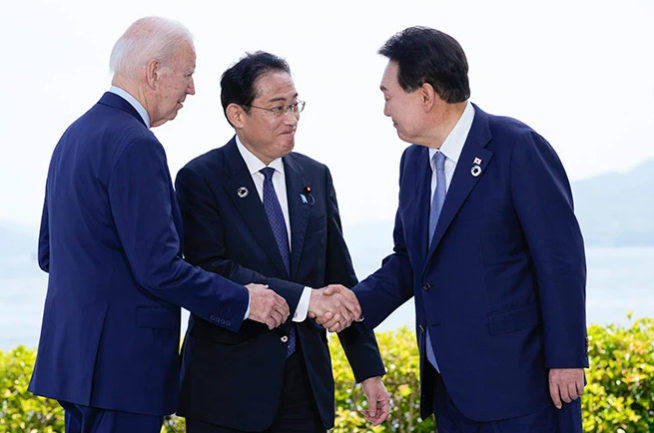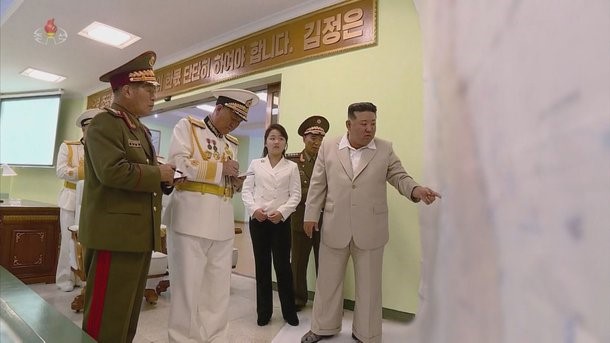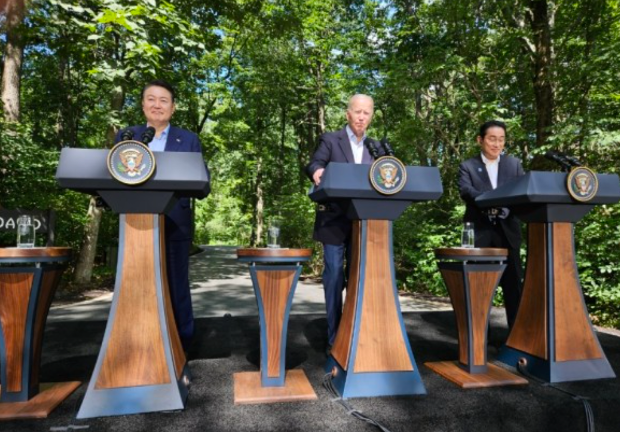
Dealing with North Korea Beyond the Korean Peninsula: Japan’s Perspective on a New Indo-Pacific Geopolitical Trend
Commentary | September 27, 2023
Kei Koga
Professor, Nanyang Technology University
Kei Koga, a Professor of Public Policy and Global Affairs at Nanyang Technology University, analyzes that deterring North Korea and shaping a rules-based regional order are the two main objectives of Japan-U.S.-ROK cooperation. In light of the recent regional dynamics moving toward bloc competition, Koga highlights that strong U.S.-Japan-ROK cooperation as well as closer Japan-ROK relations are critical for the maintenance of regional stability in Northeast Asia and the Indo-Pacific.
North Korea’s leader, Kim Jong Un, made a six-day trip to Russia in September 2023 and held a summit with President Vladimir Putin. Reportedly, Russia is strengthening its alignment with North Korea and considering military technology transfer to North Korea, including missile technology (AP Seoul 2023). Russian Foreign Minister Sergei Lavrov argued on September 13 that sanctions against North Korea was “adopted in a completely different geopolitical situation” (Trevelyan 2023). Given Russia and China’s opposition to any sanctions against North Korea proposed by the United States last year due to their failure to provide humanitarian aid, Russia would likely continue to do so in the future.
The emergence of this cordial relationship between Russia and North Korea is understandable because of their shared strategic interests. On one hand, Russia now faces operational difficulties in sustaining its protracted war against Ukraine due to a shortage of military equipment and ammunitions, some of which North Korea could provide or may have already provided. On the other hand, North Korea continuously aims to further develop its missile and nuclear capabilities. However, these developments have broader strategic implications, not only for the Korean Peninsula but also for the Indo-Pacific region.
Since the end of the Cold War, Japan, the initiator of the “Free and Open Indo-Pacific” strategy, has seen North Korea as the foremost imminent, but not so strategic threat to Japan’s security (Koga 2020). It does not see North Korea as a direct threat to the regional order in East Asia. This is mainly because North Korea’s military threat has existed locally and has essentially been contained within the Korean Peninsula and Northeast Asia.
In the post-Cold War era, the strategic ties between North Korea and its major patron states, China and Russia, have weakened because Russian power substantially declined and China maintained an ambivalent posture toward North Korea. While North Korea is important as a buffer zone on the Korean Peninsula, China was concerned about North Korea’s belligerent posture that could destabilize East Asian security. Therefore, despite North Korea’s increase in missile and nuclear capabilities in the 2010s and the intensification of US-China strategic rivalry in the Indo-Pacific region during that time, North Korea has not been factored in Japan’s Indo-Pacific strategic calculations. This is well-illustrated by Japan’s most recent National Security Strategy issued in December 2022, which regards North Korea as an immediate military threat but does not indicate any direct strategic implications for Indo-Pacific stability (MOFA Japan 2022).
This view was very much shared with the United States and Japan’s partners, given that Kim Jong Un has focused not on the enhancement of diplomatic alignment with regional powers but on strengthening North Korea’s own military capabilities, particularly attaining nuclear deterrence capabilities against the United States. Indeed, since assuming political power, Kim Jong Un has conducted two nuclear tests in 2016 and 2017, which contributed to miniaturizing nuclear warheads, and increased the frequency of ballistic missile tests since 2016 (MOFA Japan 2023). Now, the missile tests include submarine-launched ballistic missile (SLBM), inter-continental ballistic missile (ICBM), and intermediate-range ballistic missile (IRBM), developing offensive (nuclear) repertoire against the US and its allies. To respond, Japan’s strategy vis-à-vis North Korea is to deter and contain North Korea’s military threat, which entails increasing its own defense capabilities and strengthening security cooperation with the United States and South Korea.
The weakest point for this strategy had obviously been the hostile Japan-South Korea relations. During the Moon administration, its economic, security, and diplomatic relations reached its nadir—the Japan-South Korea GSOMIA (General Security of Military Information Agreement) was threatened to be abrogated; the comfort women issue and the wartime labor became increasingly politicized; military tensions rose because of the radar lock-on disputes; and a long diplomatic hiatus occurred. The United States led by President Donald Trump, which also aimed to promote alliance burden-sharing and conducted two bilateral summits with Kim Jong-Un, did not pay sufficient attention to the bilateral tension existing between two most important allies in Northeast Asia.
President Yoon Suk Yeol has altered this bilateral dynamic, mitigating the tensions with Japan and strengthening strategic ties with Japan and the United States while taking a firm stance against North Korea. Japan welcomed this posture, but it remained skeptical about whether the Yoon administration could deliver his promises. However, he successfully managed to overcome these difficult issues. The wartime labor issue was creatively resolved by South Korea’s proposal to pay compensations through a government foundation, and the GSOMIA began to be “normalized” in March 2023 (Kim and Borowiec 2023; Johnson 2023). The military tension and comfort women issues have also been politically downplayed. More recently, unlike China, South Korea accepted Japan’s explanation about the release of treated radioactive water, based on existing scientific evidence supported by IAEA that the water would not be harmful to the environment (Kim and Shin 2023).
Further, the Yoon administration resurrected shuttle diplomacy with Japan, particularly the summit diplomacy in May, and has further explored potential areas of cooperation in the Indo-Pacific region (Mori 2023). In August 15, Yoon also made a speech at the National Liberation Day that despite the negative memories of World War II, Japan is a partner that shares universal values and have common interests” to collectively respond to North Korea’s threats (Kobara 2023). This “follow-through” of the Yoon administration positively altered Japanese public perceptions, and the government started to further commit to enhancing its bilateral relations with South Korea (Cabinet Office 2023). Although political uncertainties between Japan and South Korea do not disappear because of an inevitable change in South Korea’s leadership in 2027, there have been already a number of initiatives that institutionalize bilateral and multilateral cooperation between the two (Koga 2023).
In this context, the Japan-US-South Korea trilateral summit was held at Camp David in August 2023, resulting in three documents: “Camp David Principles,” “The Spirit of Camp David,” and “Commitment to Consult.” Two elements stand out. First, the contents of Camp David Principles and the Spirit of Camp David are increasingly similar to those of the Quad, focusing on the realization of a Free and Open Indo-Pacific region (Prime Minister of Australia et al. 2023). This is largely because South Korea rolled out its Indo-Pacific strategy in December 2022, which is largely compatible to those of Japan and the United States (MOFA Korea 2022). Admittedly, the core of the trilateral cooperation continues to be North Korea, and the documents indicates new initiatives toward North Korea, such as the regularization of annual “multi-domain trilateral exercises” and the establishment of a new trilateral working group on counter-cyber threats from North Korea. However, the trilateral cooperation also went beyond the Korean Peninsula by including agendas such as economic security cooperation in the Indo-Pacific region and collective response against China’s maritime assertiveness.
Second, the “Commitment to Consult” shows shared political will to ensure the line of communication between three states. The document is short and does not impose any legal obligations but bears functional similarities to that of the Trilateral Cooperation and Oversight Group (TCOG), which aimed at information-sharing, collective messaging, and policy coordination. While institutionalizing trilateral commitment is not easy, these political efforts have become the first step to institutionalize the trilateral interaction and enhance strategic connectivity between US-Japan and US-South Korea alliances.
Furthermore, Japan and South Korea, along with the United States, indicated their diplomatic cooperation throughout the ASEAN-led forums in September 2023. The increasingly converging strategic posture toward the Indo-Pacific region can be seen in the fact that the United States and South Korea concluded joint statements on cooperation regarding the ASEAN Outlook on the Indo-Pacific, emphasizing the importance of ASEAN unity and centrality (The White House 2023; ASEAN 2023). A similar document has already been issued between Japan and ASEAN in 2020 (ASEAN 2020). These documents facilitate cooperation and policy coordination among the three nations toward ASEAN, enabling them to collectively garner diplomatic support from both ASEAN and its member states in nurturing a rules-based international order in the Indo-Pacific region that aligns with their interests. In short, the trilateral cooperation now has a two-pronged objective: deterring North Korea and shaping the Indo-Pacific regional order.
That said, the recent Russia-North Korea summit has the potential to change the strategic dynamics in the Indo-Pacific region, and this two-pronged objective may require more fine-tuning in the future. If North Korea closely aligns with Russia and gains missile and nuclear technology, North Korea will become less dependent on China. Since over 90 percent of North Korea’s trade currently depends on China, it is highly unlikely that China would lose its economic leverage over North Korea in a significant way (Frohman et al. 2022). Yet, given that Russia, in its war with Ukraine, is now willing to align with North Korea, North Korea may find itself with more negotiation advantages over Russia than before, possibly drawing a favorable deal. Moreover, if Russia continues to veto any sanction proposals against North Korea and commits to assistance advancing North Korea’s military capabilities, such actions will not only violate the UN Security Council Resolutions but also further paralyze the United Nations and degrade the existing international order. At worst, by shutting down the channels of communication and projecting aggressive postures, Russia and North Korea could trigger the division of the region and the formation of power blocs in the Indo-Pacific region.
Under such a situation, Japan would keep strengthening its security and diplomatic ties with the United States and South Korea. Good news is that such cooperation appears feasible given the existing positive trend of trilateral cooperation. Bad news is that China might use the enhancement of trilateral cooperation as part of US counter-China strategy. This could lead China to implicitly and explicitly support the Russia-North Korea cooperation, which in turn encourages North Korea’s belligerent behavior, delegitimizes and paralyzes the United Nations, and diverges the US strategic attention from the Taiwan Strait and the Indo-Pacific. North Korea’s behavior would thus have strategic implication not only for the Korean Peninsula but also for the Indo-Pacific power politics.
China holds the key (Ishida 2023). It has economic and strategic leverages over both North Korea and Russia and still holds channels of communication with the United States, Japan, and South Korea. But the window of opportunity for China to play such a role is rapidly narrowing given increasing political distrust between the United States and China. Rather than diplomatically over-relying on the United States, Japan and South Korea would use their comparative advantage, facilitating information-sharing and maintaining a channel of communication with China through the reactivation of the Japan-China-South Korea Trilateral Cooperation Framework (MOFA Japan 2019).
While the trilateral summit has been on hiatus since 2019 because of the COVID-19 and diplomatic tensions among the three states, Prime Minister Kishida and President Yoon are currently willing to hold the summit (Nikkei Asia 2023). Although this does not completely reverse the current strategic trend in the Indo-Pacific, it is important to note thatChina itself is trying to consolidate its preferred international institutions as indicated by the membership expansion of BRICS while downplaying the importance of G20, over which the United States has influences (Du Plessis et al. 2023; Foy et al. 2023). Nevertheless, there remains diplomatic room to alter the course of action that could otherwise divide the region into rival blocs. It is thus worth reviving the trilateral summit now for the maintenance of regional stability in Northeast Asia and the Indo-Pacific. To this end, Japan and South Korea must further cooperate with each other.
References
Associated Press in Seoul. 2023. “Kim Jong-un returns home after Russia trip underscoring ties with Putin.” The Guardian. September 17. https://www.theguardian.com/world/2023/sep/17/kim-jong-un-returns-north-korea-russia-trip-putin-weapon-transfer-deals
Association of Southeast Asian Nations (ASEAN). 2020. “Joint Statement of the 23rd ASEAN-Japan Summit on Cooperation on ASEAN Outlook on the Indo-Pacific.” November 13. https://asean.org/joint-statement-of-the-23rd-asean-japan-summit-on-cooperation-on-asean-outlook-on-the-indo-pacific-2/
_______________. 2023. “Joint Statement of the 24th ASEAN-Republic of Korea Summit on Cooperation on the ASEAN Outlook on the Indo-Pacific (AOIP).” September 6. https://asean.org/joint-statement-of-the-24th-asean-republic-of-korea-summit-on-cooperation-on-the-asean-outlook-on-the-indo-pacific-aoip/
Cabinet Office. 2023. “Gaiko ni kansuru yoron chosa (Reiwa4nen 10gatsu jishi)” (Public opinion regarding diplomacy [conducted in October 2022]). February 23. https://survey.gov-online.go.jp/r04/r04-gaiko/2.html#midashi13
Du Plessis, Carien, et al. 2023. “BRICS welcomes new members in push to reshuffle world order.” Reuters. August 25. https://www.reuters.com/world/brics-poised-invite-new-members-join-bloc-sources-2023-08-24/
Foy, Henry, et al. 2023. “Xi Jinping’s absence challenges G20 status as global leadership forum.” The Financial Times. September 2. https://www-ft-com.ezp.lib.cam.ac.uk/content/0d5b7b33-3fe3-41d8-b910-cec19a127313
Frohman, Ben, et al. 2022. “The China-North Korea Strategic Rift: Background and Implications for the United States.” U.S.-China Economic and Security Review Commission. January 24. https://www.uscc.gov/sites/default/files/2022-01/China-North_Korea_Strategic_Rift.pdf
Ishida, Tomonori. 2023. “北朝鮮問題をめぐる米中協調の実現に期待するバイデン政権 ―アメリカの対中政策における日米韓協力の位置づけ― (Biden administration hopes for U.S.-China cooperation on DPRK issue: Positioning of Japan-U.S.-ROK cooperation in U.S. policy toward China).” 中曽根平和究研所 日米同盟研究会 (Nakasone Peace Institute Study Group on the U.S.-Japan Alliance) 政策論議動向分析 (Policy Debate Trend Analysis) 1, 3: 1-7. https://www.npi.or.jp/research/data/aab48c95485d8f33e77e8ebbfea1bc1ccbb6e45c.pdf
Johnson, Jesse. 2023. “South Korea begins process to normalize GSOMIA intel pact with Japan.” The Japan Times. March 18. https://www.japantimes.co.jp/news/2023/03/18/national/south-korea-japan-gsomia-intelligence-sharing-normalize/
Kim, Jack and Hyonhee Shin. 2023. “South Korea sees no scientific problem with Fukushima water release plan.” Reuters. August 23. https://www.reuters.com/world/asia-pacific/south-korea-sees-no-scientific-problem-with-fukushima-water-release-plan-2023-08-22/#:~:text=The%20South%20Korean%20government%20said,water%20according%20to%20the%20plan.&text=%22We%20have%20assessed%20that%20there,contaminated%20water%2C%22%20it%20said
Kim, Jaewon and Steven Borowiec. 2023. “South Korea offers plan to end wartime labor dispute with Japan.” Nikkei Asia. March 6. https://asia.nikkei.com/Spotlight/Japan-South-Korea-rift/South-Korea-offers-plan-to-end-wartime-labor-dispute-with-Japan
Kobara, Junnosuke. 2023. “Yoon riles foes by extending olive branch to Japan in speech.” Nikkei Asia. August 16. https://asia.nikkei.com/Politics/Japan-South-Korea-ties/Yoon-riles-foes-by-extending-olive-branch-to-Japan-in-speech
Koga, Kei. 2020. “Japan’s ‘Indo-Pacific’ question: Countering China or shaping a new regional order?” International Affairs 96, 1: 49-73. https://doi.org/10.1093/ia/iiz241
_______. 2023. “Struggle for coalition-building: Japan, South Korea, and the Indo-Pacific.” Asian Politics and Policy 15, 1: 63-82. https://doi.org/10.1111/aspp.12679
Ministry of Foreign Affairs of Japan. 2022a. “Japan-China-ROK Trilateral Cooperation.” October 4. https://www.mofa.go.jp/region/asia-paci/jck/index.html
____________________________. 2022b. “National Security Strategy of Japan.” December 16. https://www.cas.go.jp/jp/siryou/221216anzenhoshou/nss-e.pdf
____________________________. 2023. “Saikin no kitachosen no misairu hassah (North Korea’s recent launch of missiles).” https://www.mofa.go.jp/mofaj/files/100439313.pdf
Ministry of Foreign Affairs of the Republic of Korea. 2023. “Strategy for a Free, Peaceful, and Prosperous Indo-Pacific Region.” Press Releases. December 28. https://www.mofa.go.kr/eng/brd/m_5676/view.do?seq=322133
Mori Eisuke. 2023. “ぶれない尹大統領、米韓同盟強化と日韓信頼回復にまい進 (President Yoon’s unwavering commitment to strengthening ROK-U.S. alliance and restoring ROK-Japan trust).” 日経ビジネス (Nikkei Business). May 15. https://business.nikkei.com/atcl/gen/19/00179/051500167/
Nikkei Asia. 2023. “Kishida, Yoon agree to work on resuming 3-way summit with China.” September 10. https://asia.nikkei.com/Politics/International-relations/Kishida-Yoon-agree-to-work-on-resuming-3-way-summit-with-China
Prime Minister of Australia, et al. 2023. “Quad Leaders’ Joint Statement.” Prime Minister of Australia. May 20. https://www.pm.gov.au/media/quad-leaders-joint-statement
The White House. 2023a. “Camp David Principles.” Briefing Room. August 18. https://www.whitehouse.gov/briefing-room/statements-releases/2023/08/18/camp-david-principles/
______________. 2023b. “The Spirit of Camp David: Joint Statement of Japan, the Republic of Korea, and the United States.” Briefing Room. August 18. https://www.whitehouse.gov/briefing-room/statements-releases/2023/08/18/the-spirit-of-camp-david-joint-statement-of-japan-the-republic-of-korea-and-the-united-states/
______________. 2023c. “Commitment to Consult.” Briefing Room. August 18. https://www.whitehouse.gov/briefing-room/statements-releases/2023/08/18/commitment-to-consult/
______________. 2023d. “ASEAN-U.S. Leaders’ Statement on Cooperation on the ASEAN Outlook on the Indo-Pacific.” Briefing Room. September 6. https://www.whitehouse.gov/briefing-room/statements-releases/2023/09/06/asean-u-s-leaders-statement-on-cooperation-on-the-asean-outlook-on-the-indo-pacific/
Trevelyan, Mark. 2023. “Russia’s Lavrov says situation has changed since North Korea was hit by U.N. sanctions.” Reuters. September 13. https://www.reuters.com/world/russias-lavrov-says-situation-has-changed-since-north-korea-was-hit-by-un-2023-09-13/
■ Kei Koga is an Associate Professor of the Public Policy and Global Affairs Programme at the School of Social Sciences, Nanyang Technology University.
■ Typeset by Jisoo Park, Research Associate
For inquiries: 02 2277 1683 (ext. 208) | jspark@eai.or.kr
Security and External Relations

The Camp David Trilateral Summit Expands Trilateralism Beyond North Korea
Scott Snyder | 21.September.2023

Significance and Implications of Kim Ju Ae’s Public Appearance
Kyong Hui Choi | 11.September.2023

Could the Trilateral Summit at Camp David Be a Game Changer?
Eunjung Lim | 01.September.2023
LIST